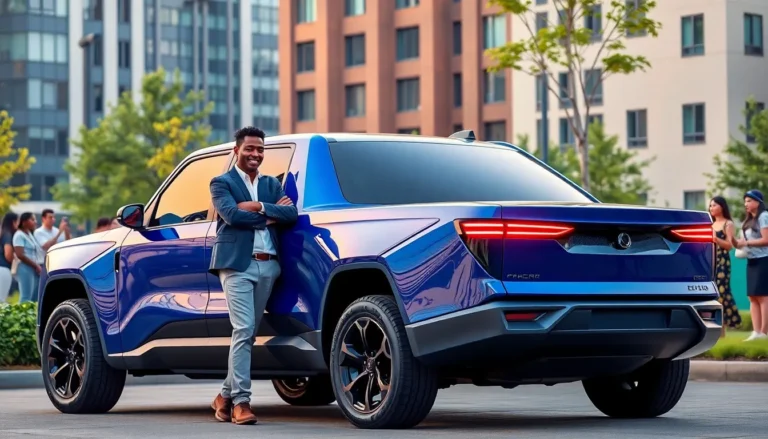Table of Contents
ToggleThe world of electric vehicles is charging ahead faster than a toddler on a sugar rush. Gone are the days when EVs were just compact cars with a side of guilt-free driving. Today, the largest electric vehicles are making waves, proving that size does matter—especially when it comes to going green.
Overview of Largest Electric Vehicles
The largest electric vehicles (EVs) represent a significant evolution in the EV market. These vehicles not only prioritize sustainability but also meet the growing demand for space and utility. Many manufacturers, such as Tesla, Rivian, and Ford, have introduced models that blend size with energy efficiency.
Tesla’s Model X, for example, features impressive cargo space and seats up to seven passengers. Rivian has gained attention with its R1T truck, known for its off-road capabilities and expansive interior. Ford’s F-150 Lightning combines the traditional truck utility with electric benefits, providing substantial towing capacity.
Statistics reinforce the impact of these larger EVs. According to industry data from 2023, sales of electric pickups surged by over 150% compared to the previous year. This surge indicates strong consumer interest and the potential for large EVs to capture significant market share.
Battery technology advancements drive the performance of these larger models. Enhanced battery packs increase range and decrease charging time, allowing larger EVs to compete with traditional gasoline vehicles in practicality. Efficient design elements also contribute to their appeal, ensuring users benefit from both size and power.
Innovative features often accompany the largest electric vehicles, offering smart technology integration and enhanced safety measures. Tesla’s Autopilot and Ford’s Co-Pilot360 are notable examples, reflecting the trend towards integrating automation and connectivity into larger EVs.
The shift towards larger electric vehicles shapes perceptions of electric mobility. As these models grow in prominence, they demonstrate that sustainability does not sacrifice functionality or capacity.
Key Players in the Market

The electric vehicle market has several influential manufacturers and innovative startups driving the growth of larger electric vehicles.
Major Manufacturers
Tesla stands out with its Model X, a spacious SUV known for its impressive range and cutting-edge technology. Rivian has made waves with its R1T truck, designed for rugged adventures and environmentally conscious consumers. Ford’s F-150 Lightning, an electric version of America’s best-selling pickup, offers both power and practicality. General Motors is also stepping into the spotlight with the Chevrolet Silverado EV, aimed at competing in the electric pickup segment. These established companies focus on integrating advanced battery technology, enhancing performance, and incorporating smart features, reshaping public perception about electric mobility.
Innovative Startups
Several startups are emerging as significant players in the electric vehicle sector. Canoo focuses on producing versatile, modular vehicles that cater to various consumer needs. Lordstown Motors aims to revolutionize the commercial electric truck market with its Endurance pickup, geared toward fleet customers. Arrival seeks to develop sustainable urban mobility solutions with its electric vans and buses. Meanwhile, Rivian is not just a truck manufacturer; it also emphasizes outdoor adventures with features tailored for exploration. Each startup prioritizes sustainability while maintaining a strong commitment to innovation and functionality, asserting their growing relevance within the industry.
Types of Largest Electric Vehicles
Larger electric vehicles are redefining the market, with categories catering to various needs. Each type emphasizes sustainability and functionality.
Electric Trucks
Electric trucks dominate the landscape with impressive capacity and performance. Models like the Rivian R1T provide off-road capabilities while maintaining eco-conscious features. High towing capacities meet the needs of both consumers and professionals. Ford’s F-150 Lightning exemplifies power and range, appealing to traditional truck buyers. These vehicles combine utility with advanced electric technology, showcasing the shift towards greener options.
Electric Buses
Electric buses significantly enhance public transport systems, offering reduced emissions and lower operating costs. Companies like Proterra design buses specifically for urban commuting, providing travelers with a cleaner alternative. These vehicles can accommodate large passenger loads, often exceeding 70 seats. Infrastructure investments support charging stations, enabling zero-emission routes across cities. Major cities worldwide are integrating electric buses, aiding in the push for sustainable urban mobility solutions.
Electric SUVs
Electric SUVs blend space and energy efficiency, catering to families and individuals. Tesla’s Model X stands out with spacious interiors and cutting-edge technology. Rivian’s R1S offers adventure-ready features alongside environmental benefits. As consumers seek multifunctional vehicles, the demand for electric SUVs grows rapidly. Innovations in safety and smart features further attract buyers, pushing brands to enhance their lineups.
Benefits of Largest Electric Vehicles
Larger electric vehicles offer significant advantages that enhance their appeal in the automotive market. These benefits range from environmental impacts to economic perks.
Environmental Impact
Larger electric vehicles contribute to reduced greenhouse gas emissions, supporting global efforts to combat climate change. By replacing traditional gasoline vehicles, they decrease air pollution, leading to cleaner urban environments. Many of these EVs utilize advanced battery technology, maximizing energy efficiency and minimizing resource depletion. Notably, electric trucks and SUVs often feature zero tailpipe emissions, promoting sustainable transportation in communities. Incorporating renewable energy sources for charging further amplifies their eco-friendly potential, ensuring a cleaner energy cycle. Manufacturers, like Rivian and Ford, emphasize these environmental benefits, aligning with consumer values aimed at sustainability.
Economic Advantages
Economic benefits become evident as larger electric vehicles gain traction. Lower operating costs associated with electric drivetrains reduce overall expenses compared to gasoline counterparts. For instance, maintenance costs tend to be lower, due to fewer moving parts in electric vehicles. Many buyers qualify for government incentives, lowering the purchase price of these EVs. Resale values for popular models, such as Ford’s F-150 Lightning, showcase strong demand, ensuring a worthwhile investment. As charging stations become more widespread, the convenience of recharging adds to their appeal. Overall, larger electric vehicles present a financially savvy choice for consumers seeking both practicality and sustainability.
Future Trends in Electric Vehicle Size
Growing demand for larger electric vehicles is evident as manufacturers introduce multifunctional designs. Electric trucks, such as Rivian’s R1T and Ford’s F-150 Lightning, prioritize capacity and performance while adhering to eco-friendly standards. Attention shifts to electric SUVs like Tesla’s Model X, which combine spacious interiors with energy efficiency, making them popular among families.
Innovative battery technology plays a crucial role in enhancing the performance of these vehicles. With advancements, larger models can compete effectively with traditional gasoline options. Increased emphasis on safety features, smart technology integration, and autonomous driving capabilities shapes consumer expectations for the future of electric mobility.
The market also sees traditional and non-traditional automakers aiming for larger electric vehicles. General Motors is working on the electric Silverado EV while startups like Canoo and Arrival focus on unique designs targeting diverse consumer needs. These companies contribute significantly to the industry’s shift towards larger models, reflecting a broader trend in sustainable transportation.
Electric buses represent another facet of this evolution, offering solutions for urban commuting with lower emissions and operational costs. Companies like Proterra are at the forefront, promoting sustainable public transport systems through their innovative electric buses. Increased emphasis on variety among larger vehicles caters to different markets and enhances the overall appeal of electric mobility.
Overall, the evolution of larger electric vehicles signals a major shift in the industry, with sustainability and functionality becoming priorities. The landscape is changing rapidly, and consumer preferences are driving the demand for more spacious and versatile EV options.
The rise of larger electric vehicles marks a pivotal moment in the automotive landscape. With manufacturers prioritizing sustainability alongside utility and performance, these vehicles are reshaping consumer expectations. The impressive advancements in battery technology and innovative features are not just enhancing efficiency but also redefining what electric mobility can offer.
As the market continues to evolve, the growing diversity of larger EVs—from trucks to buses—demonstrates a commitment to eco-friendly solutions without compromising on practicality. This shift indicates a bright future for electric vehicles, where size and sustainability can coexist, appealing to a broader audience and driving the industry forward.




